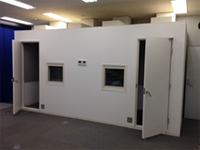Top>Education>Information environment and universities ―Rapid changes in ICT―
 Index
Index

Junichi Watanabe [profile]
Information environment and universities ―Rapid changes in ICT―
Junichi Watanabe
Assistant Executive Managing Director
Chuo University Office of the Information Technology Center
Changes in ICT environment impacting education
In the spring of 2014, I began to hear a lot about how Saga Prefecture had started introducing a new ICT environment in education. At first, everyone applauded how the prefecture had high school students purchase tablet terminals for downloading electronic textbooks to use in class. However, schools were unable to conduct classes due to frequent trouble with tablet terminals, such as the inability to download electronic textbooks. This may have been caused by a weak internet environment, problems with the tablet terminals themselves, or even by operational problems caused when all students tried to download the same material at the same time. Whatever the reason, the failure of this program became heavily criticized as having caused a retrogression in the use of ICT for education. While the program can be criticized as somewhat overly ambitious, the challenge is still being carried on today and it has affected schools throughout Japan, not just in Saga Prefecture.
Amidst such circumstances, in the summer of 2014, a teacher of a certain elementary school gave a presentation on the current use of ICT devices in children’s education. Attending the presentation were several hundred university officials. The presentation raised doubts and criticisms regarding the delay of implementing an ICT environment in universities. Despite the venue being packed with university officials, there were no counterarguments were made. As indicated by the teacher giving the presentation, the wave of ICT at rapidly changing educational institutions is now threatening to impact the very existence of universities in the future. In response to this problem, the Chuo University Office of the Information Technology Center has established two expert committees (the White Gate Project and the ICT-FD Committee). These committees have commenced a variety of testing and verification to find whether there is a path for revitalizing universities through the construction of an ICT environment.
Four key phrases for the informatization of universities
The question of how to establish an ICT environment at universities has been frequently debated since the past. Indeed, each of these debates resulted in a tentative solutions. However, modern technological advances and changes in the social environment surrounding education are moving at such a rapid speed that solutions cannot keep pace. For example, even assuming that one issue has been solved, new issues will arise twofold and threefold, creating even larger issues which need to be addressed.
I have proposed the following four key phrases for using a broad perspective to plan preparation for such issues.
- ・Computer rooms without computers
- ・Libraries without books
- ・Universities without classrooms
- ・Campuses without borders
These key phrases, which could also be called slogans, are now being used as the basis for informatization of our university. I will give a brief explanation of each phrase below.
(1) Computer rooms without computers

Together with the term BYOD (Bring Your Own Device), the environment described here is now taking shape as a specific initiative at other universities. Students, staff and faculty members use their own personal smartphones and computers to access educational services provided by the university. The university no longer prepares equipment; instead, it provides software services. This is a major change in the orientation of universities brought about by ICT.
Computer rooms without computers:
Shift in thinking from providing hardware to providing software-based services.
(2) Libraries without books

Upon hearing this phrase, people assume that I am referring to an “electronic library.” However, the electronization of existing texts is proceeding slowly due to problems such as copyright issues. This phrase actually refers to constructing a system for creating, saving, and viewing various digital contents developed by students, staff and faculty members in the future. The “creating” aspect of this system is handled by a mini photography studio established for creating video content.
Mini-Studio:
Prepared for students, staff and faculty members to create video contents and other contents upon receiving approval via the web.
(3) Universities without classrooms
Based on the idea that knowledge is not just something received from instructors in the classroom, this concept has led to current high-profile systems such as active learning and flip teaching. For example, students watch video contents at their own home in order to acquire knowledge in advance. Class time is then used to reaffirm that knowledge. Furthermore, classes can be conducted as television conferences or web conferences on the internet. This means that there is no need to prepare classrooms, thus leading to the phrase “universities without classrooms.” Of course, this concept is the subject of fierce debate and requires particularly careful attention for its potential to impact the very form of universities.
Conducting classes via satellite:
In America, universities without classrooms have existed since the 1980s. Instructors come from more than 30 universities which are famous for their science programs, including Stanford University. Some students are staff at national institutions and others are employees of corporations. Upon completing the courses, students are presented with their master’s degree. This system is also the start of MOOC.
(4) Campuses without borders

Recently, there is frequent discussion of “Super Global,” a grant issued by the Japanese government. Although some people may be uncomfortable with the naming, this grant has caused movement in global activities. It is now easier to form partnerships between countries and universities. For example, joint classes are now held by educational institutions in countries in nearly the same time zone. In some cases, students acquire IB (International Baccalaureate) to cross borders and enroll at universities in other countries. There are also students who use the internet to take overseas courses at their home (use of MOOC as discussed later). Together with advances in ICT technology, it is important to develop a response to changes in system which no longer fit within the framework of a single university.
Viewing of contents:
By using the internet, students anywhere in the world can now view materials stored in the contents saving, management and distribution environments of services such as MOOC, iTunesU, manaba, OPSIGATE and YouTube.
In this way, the four key phrases introduced above provide recommendations and guidelines for constructing the current environment while keeping an eye on changes in the future.
Growth of open education
In 2001, Chuo University collaborated with a local cable television station to produce and distribute the education program Chi no Kairo, The Corridor of Knowledge. This was an open education project unlike anything ever seen before in Japan. By introducing the daily research themes of faculty members of Chuo University, the program was intended to show how universities can contribute to the local community and society. Chi no Kairo continued to grow and is now shown throughout Japan, with broadcasting to about 4 million households.
Several years after the start of broadcasting for Chi no Kairo, MIT (Massachusetts Institute of Technology) began a program named OCW (OpenCourseWare). In this program, video recordings of all classes are made public on the internet. This made it possible to view MIT classes for free from anywhere in the world. The program became particularly widely used in developing nations. The next step in open education was the evolution into MOOC (Massive Open Online Course). Unlike OCW, which is the one-way supply of information, MOOC features Q amp;A sessions intended to firmly instill knowledge in students, the issuance of completion certificates in order to increase motivation, and even the acquisition of academic credits.
MOOC can be divided into cMOOC (a database jointly constructed by experts; for example, Wikipedia or SNS) and xMOOC (educational content posted on the internet by university faculty and other experts; for example, Coursera, Udacity, edX). Recently, particular attention is being placed on xMOOC. xMOOC includes services in which corporations provide an educational platform (Coursera, Udacity) and consortium services in which multiple universities (MIT and Harvard University) cooperate to provide an education platform (edX). In both cases, students can take university-level classes for free via the internet. In Japan, the consortium service JMOOC is attracting attention. Chuo University has participated in JMOOC since November 2014.
However, in addition to causing changes in conventional educational methods, MOOC has the potential to revolutionize the educational environment including the form of universities. Many people express concern over the lack of a clear business model for the distribution of essentially free contents. Moreover, there have been radical opinions such as “if MOOC is used, then we only need ten universities in the whole world.” For these reasons, it is only natural that people have focused on conventional educational methods will warn against the spread of MOOC. Still, we must pay attention to how the number of MOOC users is steadily growing and is now tens of millions. It is imperative that we determine a method for smoothly connecting MOOC to the current form of education. In response to this issue, some parties are attempting to modify the existing form of MOOC in order to create next MOOC. This indicates that there will be further change to the educational environment. In other words, educational officials must constantly monitor the latest conditions, focus on trends, and take swift response. If we fail to do so, we may enter an era in which the very existence of universities is threatened.
- Junichi Watanabe
Assistant Executive Managing Director
Chuo University Office of the Information Technology Center - Junichi Watanabe was born in Tokyo in 1953. In 1977, he graduated from the Department of Civil Engineering at the Chuo University Faculty of Science and Engineering. He entered employment at Chuo University in 1977. In 1992, he spent time as a Guest Researcher at the University of Illinois.
His major written works include Revival of Universities (Soryu-sha), Let’s Discuss the Future of Education (co-written; Impress R&D), Connected Education for the Future (co-written; GKB Publishing) and The Very-Beginner’s Guide to HTML (co-written; Ohmsha, Ltd.) He has been involved in production of the culture television program Chi no Kairo since 2000 (broadcasting began in 2001). He began empirical research on electronic books in 2010 and published some of his works listed above.
Outside of university, he has served as a Member of the Advertising Council at the Japan Association of Private Universities and Colleges since 2010. He has served as a founding member of the Education Cross Media Research Council since 2014. He participates in numerous other academic councils and research groups related to ICT and education. He also undertook the free public release of GKB Commons, an environment for the recording and distribution of education images. From 2012, he has held the Ted Conference on education every summer. In order to support victims of the Great East Japan Earthquake, he has participated in Sora wo Miagete activities since 2011. He conducts activities to support earthquake victims, with particular focus on providing dreams and courage to children.
- Research Activities as a Member of Research Fellowship for Young Scientists (DC1), Japan Society for the Promotion of Science (JSPS) Shuma Tsurumi
- Important Factors for Innovation in Payment Services Nobuhiko Sugiura
- Beyond the Concepts of Fellow Citizens and Foreigners— To Achieve SDGs Goal 10 “Reduce Inequality Within and Among Countries” Rika Lee
- Diary of Struggles in Cambodia Fumie Fukuoka
- How Can We Measure Learning Ability?
—Analysis of a Competency Self-Assessment Questionnaire— Yu Saito / Yoko Neha - The Making of the Movie Kirakira Megane








